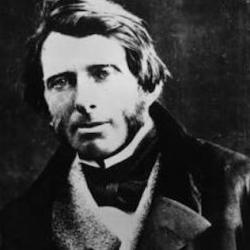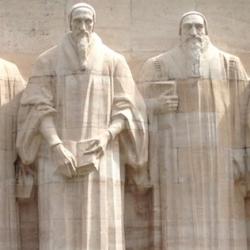In the second volume of his study of the cross in Western art (The Triumph of the Cross), Richard Viladesau notes that “the period immediately preceding the Reformation was one in which Christ’s passion was treated with graphic emphasis on the violence of the events and on the sufferings of Christ and of Mary. Their purpose was to evoke compassion and allow the viewer thereby to make the work of redemption his or her own. They used an increasing degree of naturalism in pursuit of this goal” (154). In the pre-Reformation crucifixion paintings of Lukas Cranach (the Elder), we can see this aesthetic at work.
Cranach’s later treatments of the crucifixion are very different. Citing Joseph Koerner, Viladesau writes, “Cranach’s later religious works clearly exemplify the kind of ‘crude painting’ that Luther thought appropriate to sacred art. What Luther called ‘crude, external images (groβeeusserlichebilde)’ would be unsuitable for idolatry or for a spirituality of ‘works’ based on affective identification with the images. Like Savonarola, Luther wished that religious paintings should not draw attention to the artistry or beauty, but rather should serve uniquely to convey the religious message” (154).
Other factors may have been at work – the expansion of Cranach’s workshop and his increasing use of assistants. Yet Viladesau thinks that theological changes were decisive: “after Luther’s break with Rome and Cranach’s associations with him in spreading the reformed faith, a new form emerges. We can see definite differences not only between Cranach’s early sacred pictures and his later ones, but also between the later religious works and his secular works of the same period. The differences regard the content, the degree of naturalism, and the style of the paintings. It seems fair to say, then, that in Cranach’s late crucifixions we are faced with a purposeful retreat in sacred painting from a fair degree of realistic naturalism to a more conventionalized ‘iconic’ style” (157). He discerns what Koerner calls a “mortification of painting” (quoted, 158).
A crucifixion painting of 1538 “presents a scene more typical of the late Middle Ages, with a large crowd of people, those in the foreground divided left and right between the good and the bad. At the bottom left, Mary swoons, while John and two of the women gaze at Jesus. Except for these figures, all the onlookers are dressed in sixteenth-century costume, mostly military. Again, the cross of Christ is portrayed as considerably nearer to the viewer than those of the thieves. The figure of Jesus is of the Christus Victor type, with billowing loincloth. He is alive, with no apparent wounds. He appears to be speaking. The body is conventional. Directly below the cross, and in the plane closest to the viewer, is a man in bourgeois clothing holding the hand of a small boy. The man points to Christ on the cross, like the centurion in other paintings, while addressing the child, who looks intently at him. Like the centurion, he indicates the didactic and catechetical purpose of the painting, pointing out to his child the salvific event taking place” (158).
Along these lines, Cranach painted several altarpieces bearing titles like “The Law and the Gospel” or “The Justification of the Sinner.” The paintings in the panels are metaphorical and illustrative of texts, though the figures are realistic. Each depicts salvation history from the fall through the crucifixion and resurrection, each scene linked with a specific biblical text. Cranach sometimes includes panels showing a demon chasing a man, clothed or nude, pricking him with the “sting” of sin which is the law, driving him to the cross. As Viladesau says, the message of the sequence is clear: “Justification is through faith in Christ. His blood, the symbol of his death in obedience to the Father, is the all-sufficient cause of our righteousness before God; the works of the Law are worthless to save us from the inheritance of Adam, sin, death, and hell” (162). The images are not expressive, and are not intended to evoke an emotional response. They are doctrinal affirmations rendered in paint.














